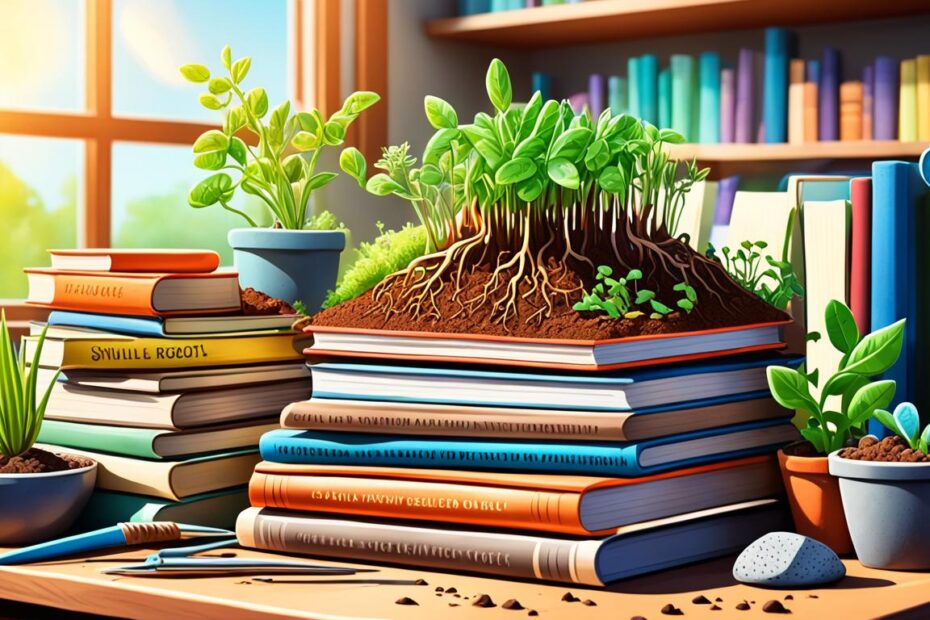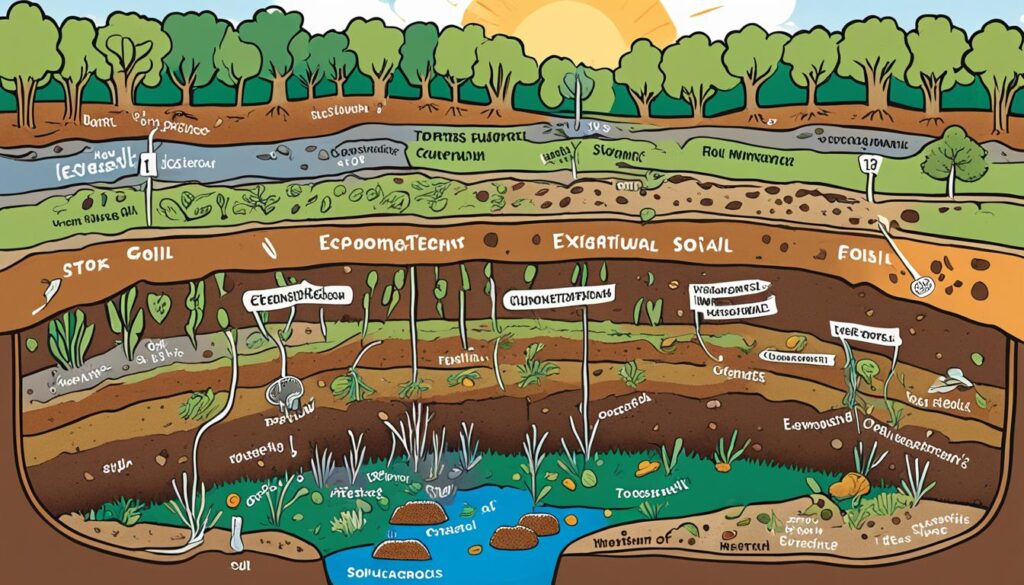Have you ever stopped to ponder the intricate world that lies beneath your feet – a world that holds the key to the sustainability of our planet? From the richness of fertile soil to the secret lives of microorganisms, soil science unveils the hidden wonders of the Earth’s most vital resource. But how can we gain a deeper understanding of this intricate ecosystem?
Discover the power of knowledge with our curated collection of the top books about soil science. These books will not only expand your understanding of soil composition and fertility but also provide insights into regenerative techniques for soil health. Delve into the realm of soil science and unearth the secrets that lie beneath the surface.
Key Takeaways:
- Soil science is essential for comprehending the composition, fertility, and role of soil in supporting plant life.
- Living soil teems with microorganisms, fungi, bacteria, and other organisms that contribute to its health and fertility.
- Regenerative techniques such as no-till gardening and composting can help restore soil health and promote sustainability.
- Assessing soil health through soil testing is crucial for optimizing gardening and farming practices.
- Becoming an advocate for soil health involves raising awareness and supporting policies for sustainable agriculture and soil conservation.
The Importance of Soil Science
Soil is not just dirt beneath our feet; it is a vital resource that plays a crucial role in supporting life on Earth. Understanding the importance of soil science is essential for unlocking the secrets of soil composition, fertility, and its impact on plant life. By delving into the world of soil science, we can gain valuable insights into the intricate web of interactions that occur within the soil ecosystem.
Soil science enables us to comprehend the composition of soil, including its mineral content, organic matter, and moisture levels. This knowledge is crucial for optimizing agricultural practices, as it helps us determine the soil’s nutrient content and its suitability for different crops. By understanding soil composition, farmers and gardeners can make informed decisions about fertilization, irrigation, and soil amendments, leading to improved productivity and sustainable land management.
Moreover, soil science empowers us to explore the role of soil in environmental conservation. Soil acts as a natural carbon sink, sequestering carbon dioxide from the atmosphere and mitigating climate change. Understanding how soil contributes to carbon sequestration allows us to develop strategies for managing land in a way that enhances its carbon storage capacity and reduces greenhouse gas emissions.
The field of soil science also sheds light on the intricate relationships between soil, water, and plant life. By studying soil composition and its ability to retain and release water, scientists and land managers can develop effective strategies for water management, reducing erosion, and preventing soil degradation. These efforts are vital for preserving soil fertility, safeguarding ecosystems, and ensuring sustainable water resources for future generations.
In summary, the importance of soil science cannot be overstated. It provides us with the knowledge and understanding needed to unlock the secrets of soil composition, fertility, and its role in promoting sustainable agriculture and environmental conservation. By valuing and investing in soil science, we can protect and nurture this precious resource for the benefit of present and future generations.
CLICK HERE TO CHECK OUR RECOMMENDED PRODUCTSExploring the World of Living Soil
Soil is not just a lifeless substance; it is teeming with life and organisms that contribute to its health and fertility. Understanding the intricate web of interactions between microorganisms, fungi, bacteria, and other soil organisms is essential in harnessing the power of living soil. When we recognize soil as a complex ecosystem, we unlock its potential for sustaining and nourishing life.
Books about soil science provide a captivating glimpse into this hidden world beneath our feet. They dive deep into the fascinating processes that occur within the soil ecosystem, revealing the incredible interconnectedness of its inhabitants. Through these books, you can embark on a journey of discovery and gain valuable insights into the delicate balance that exists within living soil.
One such essential component of living soil is microorganisms. These tiny organisms, including bacteria and fungi, play a crucial role in breaking down organic matter, releasing nutrients, and maintaining soil structure. They form symbiotic relationships with plant roots, aiding in nutrient uptake and enhancing plant growth. Books about soil science often highlight the diverse range of microorganisms found in healthy soil and their indispensable contributions to soil fertility.
Astounding visuals and detailed descriptions in books about soil science bring the intricate soil ecosystem to life. The mesmerizing interplay between roots, soil particles, and organisms is beautifully depicted, giving us a deeper understanding of the complex dynamics at play. By exploring these resources, you can gain a profound appreciation for the extraordinary world that lies beneath our feet.
“Soil is not just a substrate; it is a living entity, a true ecosystem that sustains all life on Earth.”
Moreover, books about soil science shed light on the crucial role of soil organisms in sequestering carbon and mitigating climate change. They explain how living soil acts as a natural carbon sink, storing vast amounts of carbon and supporting the delicate balance of our planet’s ecosystems.
By delving into the world of living soil through books about soil science, you can gain a newfound respect for this vital resource. You’ll discover the intricate relationships between soil organisms and plant life, the remarkable processes that sustain soil fertility, and the critical role of living soil in environmental conservation.
| Benefits of Understanding Living Soil: |
|---|
| Enhanced nutrient availability for plants |
| Improved soil structure and water retention |
| Increased carbon sequestration and climate mitigation |
| Promotion of biodiversity and ecosystem balance |
| Support for sustainable and regenerative agriculture |
Techniques for Soil Regeneration
Regenerating soil is a fundamental aspect of sustainable agriculture. The practice of regenerative agriculture aims to restore soil health, enhance productivity, and promote environmental sustainability. By adopting regenerative techniques, you can play a crucial role in revitalizing the soil and creating a more resilient agricultural ecosystem.
Books about soil science offer valuable insights into various techniques that promote soil regeneration. These techniques include:
- No-till gardening: This method involves minimizing soil disturbance by avoiding traditional tilling practices. Instead, the soil is left undisturbed, allowing natural processes to take place. No-till gardening helps preserve soil structure, reduce erosion, and enhance water retention capacity.
- Efficient composting: Composting is a powerful tool for soil regeneration. By recycling organic waste materials, you can create nutrient-rich compost that improves soil fertility and structure. Books about soil science provide guidance on effective composting methods, helping you harness the full potential of compost for soil regeneration.
- Mulching: Mulching involves covering the soil surface with organic material, such as straw or wood chips. This protective layer helps regulate soil temperature, suppress weed growth, retain moisture, and enhance organic matter content. By practicing mulching, you can create favorable conditions for soil organisms and promote long-term soil health.
Soil regeneration techniques such as no-till gardening, efficient composting, and mulching offer sustainable and effective ways to restore soil health and promote environmental sustainability. By implementing these practices, you can contribute to the regeneration of our precious soil and create a thriving agricultural ecosystem.
Remember, soil regeneration is a continuous process that requires patience and dedication. By incorporating these techniques into your gardening or farming practices, you can foster healthy soil for future generations to come.
Unveiling the Secrets of Soil Health
Soil health is the cornerstone of successful plant growth and high agricultural productivity. Understanding the quality and condition of your soil is essential for optimizing your gardening or farming practices. Books about soil science offer invaluable guidance on assessing soil quality and conducting soil tests to gain insights into its health.
By delving into the indicators of soil health and learning how to improve it, you can unlock the potential of your land and achieve better yields. Assessing soil quality involves examining factors such as pH levels, nutrient concentrations, soil structure, and the presence of pollutants or contaminants.
Soil testing plays a vital role in this process, providing valuable data to understand the current state of your soil and determine any necessary amendments. Through soil testing, you can uncover nutrient deficiencies or excesses, identify potential environmental issues, and tailor your fertilization and soil management practices accordingly.
Benefits of Assessing Soil Quality and Conducting Soil Tests
- Promote plant health and growth: By understanding the specific needs of your soil, you can provide the right balance of nutrients and create an optimal environment for plants to thrive.
- Ensure sustainable agricultural practices: Assessing soil quality allows you to adopt sustainable farming techniques that reduce soil erosion, minimize nutrient runoff, and protect water resources.
- Save time and costs: Conducting soil tests can help you determine the most effective and efficient use of fertilizers and soil amendments, reducing unnecessary expenses and environmental impact.
By utilizing the knowledge gained from books about soil science, you gain the power to unlock the secrets of your soil health. Armed with this understanding, you can make informed decisions that optimize your agricultural practices, increase productivity, and contribute to the overall sustainability of your land.
| Benefits of Assessing Soil Quality and Conducting Soil Tests | Details |
|---|---|
| Promote plant health and growth | Understand and provide the necessary nutrients for plants to thrive |
| Ensure sustainable agricultural practices | Adopt techniques that minimize erosion, nutrient runoff, and protect water resources |
| Save time and costs | Optimize fertilizer and soil amendment usage, reducing expenses and environmental impact |
To illustrate the benefits of assessing soil quality and conducting soil tests, let’s hear from Jane, an experienced farmer who implemented these practices:
“Once I started assessing the quality of my soil and conducting regular soil tests, I noticed a significant improvement in my crop yields. By identifying nutrient deficiencies and adjusting my fertilization practices accordingly, my plants became healthier and more abundant. Not only did this save me time and resources, but it also allowed me to farm sustainably, preserving the long-term health of my soil.”
– Jane Thompson, Farmer
Through the guidance provided by books about soil science, you can demystify soil health and unveil the secrets hidden beneath the surface. Embracing soil assessment techniques and soil testing empowers you to optimize your agricultural endeavors, nurture your soil’s health, and cultivate a sustainable future.
CLICK HERE TO CHECK OUR RECOMMENDED PRODUCTSBecoming an Advocate for Soil Health
Promoting soil health is not just about individual practices; it is also about advocating for sustainable agriculture and soil conservation. By becoming an advocate for soil health, you can play a crucial role in protecting and preserving this vital resource for future generations.
Why Advocacy Matters
Advocacy for soil health is essential because it raises awareness about the importance of sustainable agriculture and soil conservation. By educating others about the benefits of healthy soil, you can inspire individuals, communities, and policymakers to take action.
Raising Awareness
Books about soil science can equip you with the knowledge and strategies to effectively raise awareness about soil health. By sharing your insights and discussing the importance of soil conservation, you can inspire others to make sustainable choices that promote soil health.
Supporting Policies
Advocacy also involves supporting policies that promote sustainable agriculture and soil conservation. By staying informed about relevant legislation and initiatives, you can actively engage with policymakers and organizations working towards a more sustainable future.
Contributing to a Sustainable Future
As an advocate for soil health, you have the power to contribute to a more sustainable future. By promoting sustainable agricultural practices and soil conservation efforts, you can help protect our environment, enhance food security, and preserve the health of our ecosystems.

The Power of Soil in Environmental Conservation
Soil is not just the foundation beneath our feet; it is also a powerful ally in environmental conservation. Through the process of carbon sequestration, soil acts as a natural carbon sink, helping to mitigate climate change and reduce the concentration of greenhouse gases in the atmosphere.
Books about soil science shed light on the vital role of soil in maintaining ecosystem balance and preserving biodiversity. They reveal how soil acts as a living ecosystem, hosting a diversity of microorganisms, insects, and plant roots that contribute to its health and fertility.
Understanding soil’s role in environmental conservation is crucial for protecting our natural resources. By nourishing and restoring soil health, we can promote sustainable agriculture and ensure the long-term sustainability of our planet.
The Role of Soil in Carbon Sequestration
Soil plays a critical role in carbon sequestration, the process of capturing and storing carbon dioxide from the atmosphere. Through organic matter decomposition and plant root systems, soil traps carbon dioxide and retains it within its structure.
“Soil is a living filter, cleansing the air we breathe and the water we drink. It’s the foundation that sustains life on Earth.” – Dr. Sylvia Earle
This carbon sequestration process helps to offset the carbon emissions produced by human activities, such as burning fossil fuels and deforestation. By protecting and enhancing soil health, we can maximize its carbon sequestration potential and contribute to mitigating climate change.
Preserving Ecosystem Balance and Biodiversity
Soil is not only essential for carbon sequestration but also for maintaining ecosystem balance and preserving biodiversity. Healthy soil provides a rich habitat for numerous organisms, including beneficial microbes, insects, and earthworms, which contribute to the overall health and resilience of the ecosystem.
By promoting soil health and biodiversity, we can create a sustainable environment where plants, animals, and microorganisms thrive together in harmony. This balanced ecosystem supports diverse plant and animal species, protects water quality, and enhances the overall resilience of natural habitats.
The Importance of Soil in Protecting Natural Resources
Soil serves as a valuable resource that supports various essential functions in our daily lives. It serves as a natural water filter, purifying and replenishing groundwater supplies. It also acts as a reservoir, storing and slowly releasing water during periods of drought or heavy rainfall, helping to prevent flooding and erosion.
Books about soil science provide insights into the importance of soil in protecting these natural resources. They highlight the need to adopt sustainable land management practices to prevent soil degradation, erosion, and loss of fertility. By valuing and protecting our soil resources, we can ensure their long-term availability and sustainability for future generations.
Through a deeper understanding of soil’s crucial role in environmental conservation, we can work towards a more sustainable and resilient planet. By implementing practices that enhance soil health, promote carbon sequestration, and preserve ecosystem balance, we can contribute to the protection of our natural resources and the overall wellbeing of our planet.
Conclusion
In conclusion, the study of soil science through books is an invaluable pursuit for anyone seeking to deepen their knowledge and understanding of soil. These books provide valuable insights into the intricacies of soil composition, the vital role of soil organisms, and effective techniques for improving soil health.
By delving into the secrets of soil, we gain a profound appreciation for its significance in sustainable agriculture and environmental conservation. Understanding soil science allows us to make informed decisions to protect and nourish this precious resource, ensuring the wellbeing of our planet.
Through the knowledge gained from books about soil science, we can actively contribute to the advancement of practices that promote sustainable agriculture, soil restoration, and the preservation of our natural resources. By unlocking the secrets of soil, we hold the key to fostering a more resilient, balanced, and thriving ecosystem that benefits both present and future generations.
FAQ
Can books about soil science help me understand the composition of soil?
Yes, books about soil science provide valuable insights into the composition of soil and how it affects plant life and fertility.
How can books about soil science help with regenerative techniques for soil health?
Books about soil science offer guidance on regenerative techniques such as no-till gardening, efficient composting, and mulching, which can improve soil health and promote sustainable agriculture.
Can books about soil science help me assess the health of my soil?
Yes, books about soil science can provide guidance on assessing soil quality and conducting soil tests to understand the health of your soil.
Can books about soil science help me become an advocate for soil health?
Absolutely! Books about soil science can equip you with knowledge and strategies to raise awareness, support policies that promote soil conservation, and contribute to a more sustainable future.
How does soil play a role in environmental conservation?
Soil acts as a natural carbon sink, helping to mitigate climate change through carbon sequestration. Books about soil science can shed light on the importance of soil in maintaining ecosystem balance, preserving biodiversity, and protecting our natural resources.

